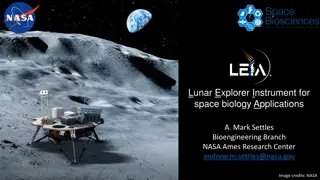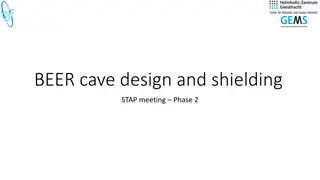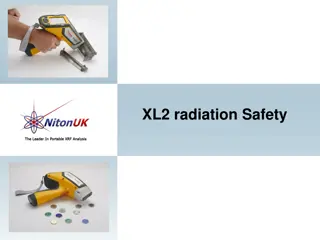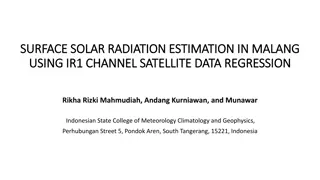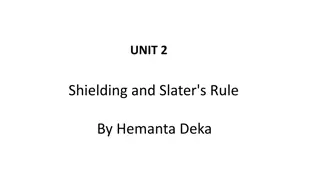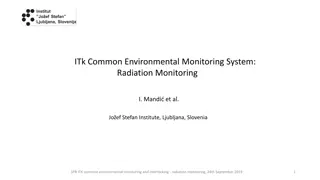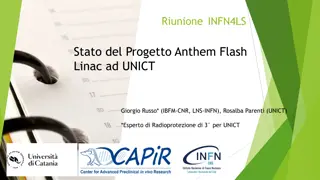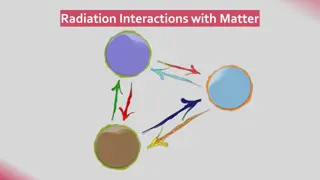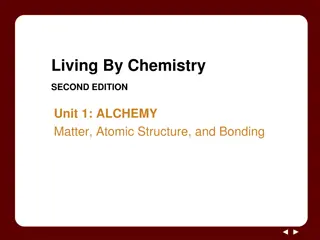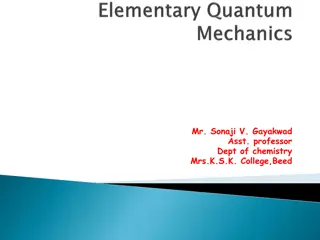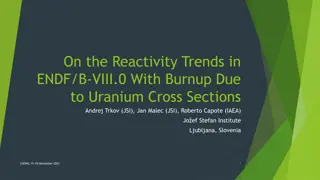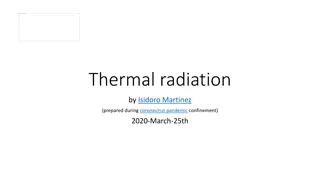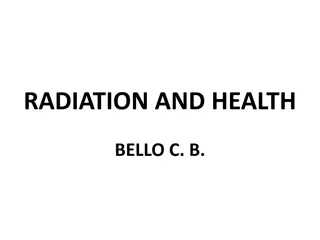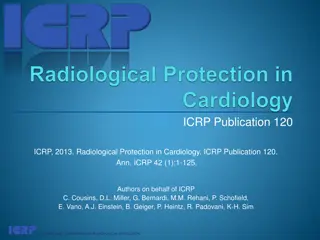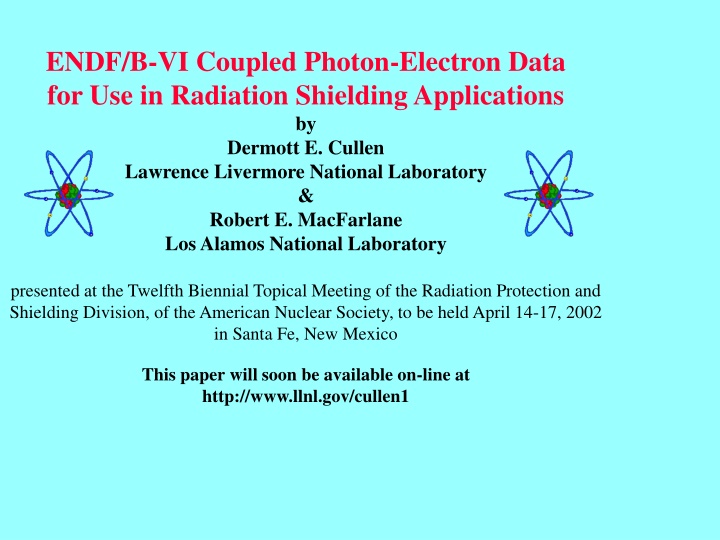
ENDF/B-VI Coupled Photon-Electron Data for Radiation Shielding Applications
This paper discusses the importance of photon-electron data in radiation shielding, including details on photon and electron interaction data, codes for accurate radiation transport methods, and the improvement in data bases over the years. It highlights the advancements in photon and electron data libraries for better accuracy and calculations in radiation shielding applications.
Download Presentation

Please find below an Image/Link to download the presentation.
The content on the website is provided AS IS for your information and personal use only. It may not be sold, licensed, or shared on other websites without obtaining consent from the author. If you encounter any issues during the download, it is possible that the publisher has removed the file from their server.
You are allowed to download the files provided on this website for personal or commercial use, subject to the condition that they are used lawfully. All files are the property of their respective owners.
The content on the website is provided AS IS for your information and personal use only. It may not be sold, licensed, or shared on other websites without obtaining consent from the author.
E N D
Presentation Transcript
ENDF/B-VI Coupled Photon-Electron Data for Use in Radiation Shielding Applications by Dermott E. Cullen Lawrence Livermore National Laboratory & Robert E. MacFarlane Los Alamos National Laboratory presented at the Twelfth Biennial Topical Meeting of the Radiation Protection and Shielding Division, of the American Nuclear Society, to be held April 14-17, 2002 in Santa Fe, New Mexico This paper will soon be available on-line at http://www.llnl.gov/cullen1
ENDF/B-VI Coupled Photon-Electron Data for Use in Radiation Shielding Applications For use in Shielding Applications we need Photon Interaction Data including direct secondary photons and electrons Electron Interaction Data including direct secondary photons and electrons Data for ALL Photon-Electron Coupling Fluorescence X-Rays and Auger Electrons Computer Codes to Use This data Using Accurate Radiation Transport Methods Monte Carlo Data is Useless without Codes Codes are Useless without Data
ENDF/B-VI Coupled Photon-Electron Data for Use in Radiation Shielding Applications In order to meet these needs, in the Last Few years Photon and Electron Data Bases have been Greatly Improved In terms of the Details Included the Accuracy of the Data At the Same time there has been an Enormous Increase in Available Inexpensive Computer Power Today s Personal Computers = Yesterday s Super Computers The Combination allows us to Today Calculate Results in Greater Detail to Greater Accuracy Using Accurate Methods, such as Monte Carlo Which was not possible just a few years ago
ENDF/B-VI Coupled Photon-Electron Data for Use in Radiation Shielding Applications We now have Three Different Data bases the Evaluated Photon Data Library, `97 version (EPDL97) Interaction of Photons with matter plus direct production of Photons and Electrons the Evaluated Electron Data Library (EEDL) Interaction of Electrons with matter plus direct production of Photons and Electrons the Evaluated Atomic Data Library (EADL) Relaxation of Ionized Atoms Back to Neutrality Emission of Photons (fluorescence) and Electrons (Auger)
ENDF/B-VI Coupled Photon-Electron Data for Use in Radiation Shielding Applications These Libraries are Designed to be Used in Combination for Detailed Coupled Photon-Electron Radiation Transport Calculations all contain. Elemental Data for Z = 1 through 100 (H through Fm) Over the Energy Range 10 eV to 100 GeV All Are Consistent, They all have the Same Subshell Binding Energies All Contain More Detail than Previously Available For example, Atomic Subshell Cross Sections Due to Limited Time I ll Only Cover EPDL97 in Detail for EEDL and EADL, See the website http://www.llnl.gov/cullen1
ENDF/B-VI Coupled Photon-Electron Data for Use in Radiation Shielding Applications Let s first look at the improved detailed in our data Traditional Photon Interaction Data Included Cross Sections Coherent and Incoherent Scattering Photoelectric Absorption Pair Production Form Factors Describe Angular Distribution of Coherent Scattered Scattering Functions Describe Angular Distribution of Incoherent Scattered That s ALL
ENDF/B-VI Coupled Photon-Electron Data for Use in Radiation Shielding Applications This is Sufficient to Describe Emission of Primary Photons Incoherent/Coherent Scatter Not Sufficient to Describe Secondary Photons Secondary Fluorescence Photons Secondary Bremsstrahlung Photons In-Flight Positron Annihilation Not Sufficient to Describe Low Energy Scattering No Anomalous Scattering Does Not Differentiate Between Pair Production Triplet Production
ENDF/B-VI Coupled Photon-Electron Data for Use in Radiation Shielding Applications EPDL97 includes extra Detail Photoelectric Subshell Cross Sections Allows accurate fluorescence, Auger yield Pair and Triplet Production Cross Sections Different Kinematics for Each Anomalous Scattering Factors ENORMOUS change in low energy coherent scattering Used with EEDL to define Bremsstrahlung Positron In-flight Annihilation The result is Complete Photon-Electron Coupling
ENDF/B-VI Coupled Photon-Electron Data for Use in Radiation Shielding Applications Figure 1 illustrates the Traditional Photon Cross Sections for Lead Basically just four cross sections Coherent Scattering Incoherent Scattering Photoelectric absorption Pair Production
ENDF/B-VI Coupled Photon-Electron Data for Use in Radiation Shielding Applications photoelectric 4 basic lead cross sections coherent pair incoherent 10 eV 100 GeV
ENDF/B-VI Coupled Photon-Electron Data for Use in Radiation Shielding Applications In order to illustrate the increase in Detail in our Current Photon Data Bases (EPDL97) Figure 2 illustrates the Lead Photoelectric Subshell Cross Sections Compared to the four Traditional Cross Sections Where No Further detail is available Here we have Cross Sections for each of the 24 Subshells Each subshell has its own Binding energy and its own Photon and Electron Emission Spectra the Spectra are defined by Our EADL Data Base
ENDF/B-VI Coupled Photon-Electron Data for Use in Radiation Shielding Applications 24 photoionization subshell cross sections 10 eV 100 GeV
ENDF/B-VI Coupled Photon-Electron Data for Use in Radiation Shielding Applications Figure 3 illustrates Similar Detail for the Lead Electron Ionization Subshell Cross Sections - from EEDL Compared to Traditional Electron transport Where only one Average Ionization is Defined Here we have Cross Sections for each of the 24 Subshells Each Contributes differently to Electron Ionization Each subshell has its own Binding energy and its own Photon and Electron Emission Spectra the Spectra are defined by Our EADL Data Base
ENDF/B-VI Coupled Photon-Electron Data for Use in Radiation Shielding Applications 24 electroionization subshell cross sections 10 eV 100 GeV
ENDF/B-VI Coupled Photon-Electron Data for Use in Radiation Shielding Applications Question: Do we really need all of this extra detail? Are Photoelectric Subshell Cross Sections Really Needed? Traditionally it was Assumed that each photoelectric absorption resulted in all of the energy of the incident photon being deposited at the point of the absorption. In lead a 88.3 keV photon would deposit 88.3 keV of energy Based on our EADL data Figure 4 illustrates that when a photon undergoes photoelectric absorption just above the lead K-Edge at 88.3 keV, 77.6 keV (87.9 % of its energy) is Re-emitted as Fluorescence X-Rays and only 10.7 keV is deposited. 88.3 keV versus 10.7 keVdeposited The traditional result is 850 % too HIGH
ENDF/B-VI Coupled Photon-Electron Data for Use in Radiation Shielding Applications Each Green point represents a discrete x-ray emission line Discrete lines and Integral of the lines The Red curve represents the integral over the x-ray emission lines 10 eV 100 keV
ENDF/B-VI Coupled Photon-Electron Data for Use in Radiation Shielding Applications Question: Is Anomalous Scattering Important? Returning to Figure 1, note that near 10 eV the Lead Coherent Scattering Cross section, which includes the effect of Anomalous Scattering, is About 10 Barns In Contrast the Traditional Coherent Scattering Cross section is About 4,480 barns 4,480 barns versus 10 barns Traditional value is a Factor of 448 too large
ENDF/B-VI Coupled Photon-Electron Data for Use in Radiation Shielding Applications 1) Coherent near 10 eV is really about 10 barns Coherent 2) Traditional value Is 4,480 barns 10 eV 100 GeV
ENDF/B-VI Coupled Photon-Electron Data for Use in Radiation Shielding Applications In the limited Time Available I have Mostly Discussed EPDL97 EPDL97 is Designed to be Used with EEDL & EADL to Perform Complete Coupled Photon-Electron Radiation Transport Calculations the Evaluated Photon Data Library, 97 version (EPDL97) Interaction of Photons with matter plus direct production of Photons and Electrons the Evaluated Electron Data Library (EEDL) Interaction of Electrons with matter plus direct production of Photons and Electrons the Evaluated Atomic Data Library (EADL) Relaxation of Ionized Atoms Back to Neutrality Emission of Photons (fluorescence) and Electrons (Auger)
ENDF/B-VI Coupled Photon-Electron Data for Use in Radiation Shielding Applications Recently we ve improved our availability to accurately model photon-electron transport But as yet we are NOT YET where we would like to be There are Still Improvements and Extensions to make For complete Details see the EPDL97 Documentation On-line at http://www.llnl.gov/cullen1 Here I ll Only Mention Photonuclear Still not included in EPDL97 but data is now available Potentially Important in Many Applications Positive Effect: Strong, Localized Energy Deposit Tumors Negative Effect: Activates your accelerator
ENDF/B-VI Coupled Photon-Electron Data for Use in Radiation Shielding Applications These Data Bases are useless without computer codes That prepare them for use in applications (NJOY) And use them in applications (TART) The TART Monte Carlo code has used these data bases for a number of years So they have a track record that shows improved results Only recently data bases were adopted within ENDF/B-VI Now NJOY is being updated Soon NJOY results will be generally available For use in MCNP & Sn codes
ENDF/B-VI Coupled Photon-Electron Data for Use in Radiation Shielding Applications In This paper I ve Introduced our Data Bases Particularly our photon Data Base EPDL97 EPDL97 is Designed to Meet the Needs of Tradition Data users with Less Details No Additional photons: Fluorescence or Bremsstrahlung As well as Those Users who want to Use More Details by Simply including Fluorescence X-Rays or also Bremsstrahlung without Electron Transport or Complete Coupled Photon-Electron transport You are free to use as little or as much detail as you want
ENDF/B-VI Coupled Photon-Electron Data for Use in Radiation Shielding Applications Lastly I ll Mention that All three Data Bases Are now FREELY!! Available - Internationally See the website http://www.llnl.gov/cullen1 Where you can obtain copies of documentation and find out how to obtain Data Bases through International Code centers And now available on-line I ll again stress that these data bases are useless without codes to prepare and use them Soon NJOY results will be available for use

